Workplace pension participation and savings trends of eligible employees: 2009 to 2020
Updated 21 September 2021
This is the latest release of statistics on Workplace Pension Participation and Savings Trends between 2009 and 2020. This is the eighth edition in the series and provides additional information on the trends over the COVID-19 period on pension saving and contributions.
After years of growth in participation during the roll-out of automatic enrolment, participation rates have stabilised. Trends in stopping saving and contributions have remained relatively stable during the COVID-19 period.
Introduction
Automatic enrolment was introduced in 2012 to help address the decline in private pension saving and to make long-term saving the norm. It aims to increase workplace pension saving in the UK and forms part of a wider set of pension reforms designed to enable individuals to achieve financial security in retirement.
The roll-out of automatic enrolment was completed following implementation of the contribution increase in April 2019. This official statistics publication will explain both the post-implementation picture of automatic enrolment and the trends over the COVID-19 period.
Part 1 of the main stories section provides breakdowns of 2 key measures for evaluating the implementation of automatic enrolment:
- increasing the number of savers, by monitoring trends in workplace pension participation
- increasing the amount of savings, by monitoring trends in workplace pension saving
Part 2 of the main stories section provides information on trends in stopping saving and contributions until March 2021 for evaluating the trends over the COVID-19 period.
The Office for National Statistics (ONS) Annual Survey of Hours and Earnings (ASHE) is the main data source used in this publication and is the key source of information on participation and contributions.
Supplementary data sources used include Department for Work and Pensions (DWP) Family Resources Survey and HM Revenue and Customs (HMRC) Real-Time Information to provide information on ethnicity, disability and economic status breakdowns in participation and stopping saving and contributions over the COVID-19 period respectively.
Main stories
Part 1. What is the post-implementation picture of automatic enrolment?
Overall 88% of eligible employees (19.4 million) were participating in a workplace pension in 2020. Overall trends in participation have increased since 2012, driven by the private sector while public sector participation has remained high.
Eligible employee participation rate to 2020
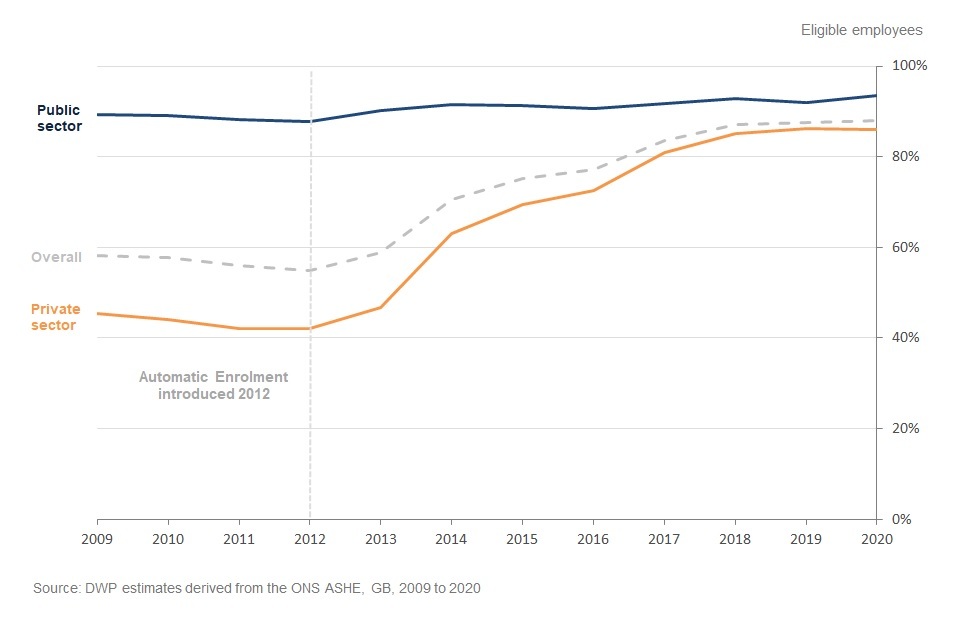
- trends across all breakdowns broadly reflect this overall picture of participation in the public and private sector
- since 2012, many gaps in participation have narrowed – the largest increases have been seen in Agriculture & Fishing and Distribution, Hotels & Restaurants industries and among small employers (5 to 49 employees)
- most groups have seen trends in participation stabilise between 2018 and 2020
- there are some gaps that remain in 2020 and there is relatively low participation of below 65% for some eligible groups including micro employers and Pakistani & Bangladeshi employees
ONS Employee Workplace Pensions in the UK also includes information on pension participation rates for all employees, both eligible and non-eligible. This publication also uses ASHE data and shows a similar trend in participation for all employees as we have observed for eligible employees. Workplace pension participation of UK employees increased between 2012 and 2020, up from less than half to 78% of UK employees, before stabilising in recent years.
Total annual savings for eligible savers increased to £105.9 billion in 2020.
Amount saved by eligible employees in 2020
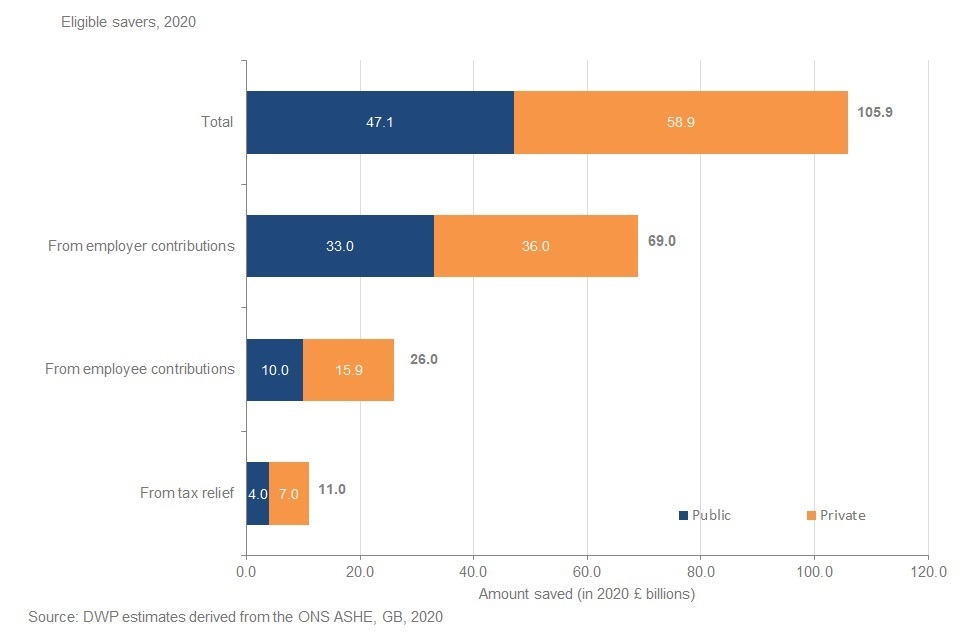
Part 2. What are the trends over the COVID-19 period?
Stopping saving rates in RTI have decreased slightly compared to previous years. Employee pension contribution rates in RTI have remained stable throughout the financial year 2020 to 2021.
Stopping saving rates to financial year 2020 to 2021
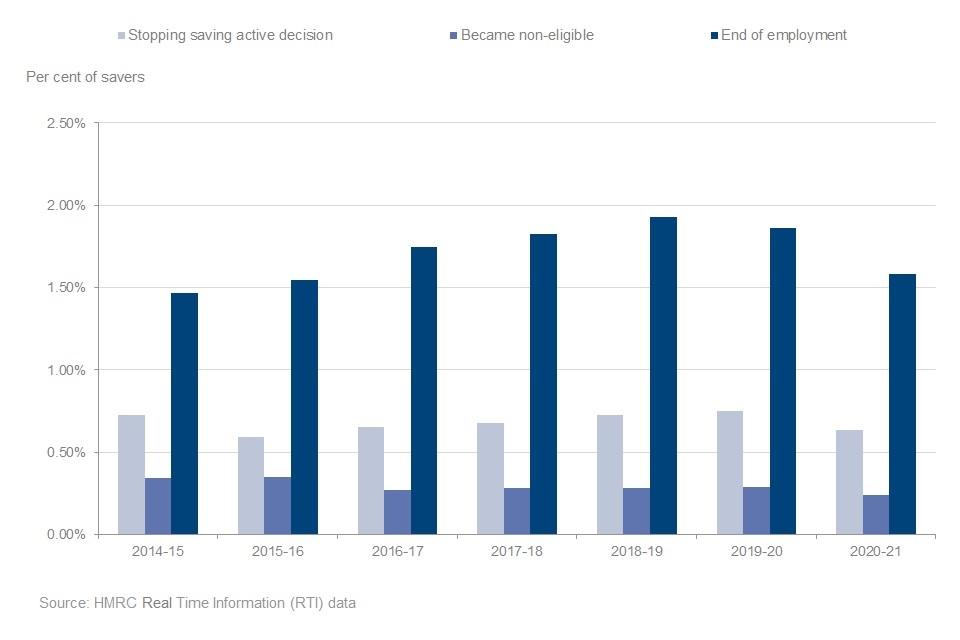
- in the financial year 2020 to 2021, the overall stopping saving level has decreased, mainly driven by a fall in those stopping saving due to ending their employment, which fell from 1.9% to 1.6%
Employee pension contribution rates with pay within AE thresholds to Q4 (Jan to Mar) 2020-21
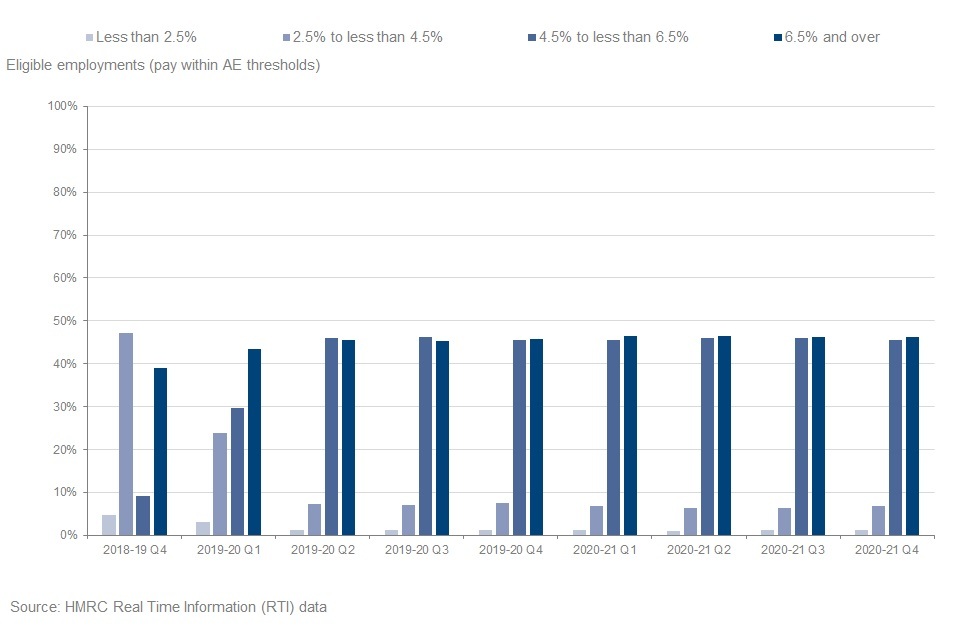
ONS Funded occupational pension schemes in the UK also includes information on employee contributions over the COVID-19 period. A fall in employee contributions was observed between Q1 (Jan to Mar) and Q2 (Apr to Jun) 2020, followed by a subsequent recovery in Q3 (Jul to Sep) 2020. Between Q3 (Jul to Sep) and Q4 (Oct to Dec) 2020, recovery continued with employee pension contributions increasing in all scheme types. These findings are broadly comparable with trends observed in HMRC RTI data, both showing that recent levels are similar to pre-COVID levels.
What you need to know
Automatic enrolment mandates employers to provide a workplace pension for all workers meeting certain criteria. See the Background information and methodology note for detailed information about eligibility and contribution rates.
Throughout this report eligible employees are defined as employees who meet the automatic enrolment age and earnings criteria in that year. See the background information and methodology note for full definitions.
Notes
The analysis includes members of all qualifying workplace pension schemes: occupational pension schemes, group personal pensions (GPPs), and group stakeholder pensions (GSHPs). All analysis is based on eligible employees, and uprated using ONS Average Weekly Earnings values.
Subgroup analysis in this publication does not include an assessment of which factors are the primary drivers of differences in participation across different subgroups.
Numbers have been suppressed where the sample size is small. Charts show the percentage of eligible employees participating in a workplace pension unless otherwise stated. We welcome feedback on the material provided to improve future releases.
All the information presented in the charts and figures is included in the accompanying excel tables.
1. Trends in Workplace Pension Participation
The proportion of private sector eligible employees participation in a workplace pension increased sharply between 2012 and 2018 before stabilising. Public sector participation remains high.
Eligible employee participation rate to 2020

Overall participation of eligible employees is 88% (19.4 million eligible employees), similar to 2019.
Across the whole economy, there was a general downward trend in workplace pension participation among eligible employees between 2009 and 2012, from 58% (11.4 million eligible employees) to a low of 55% (10.7 million eligible employees). Since 2012, there has been a large increase of 8.7 million to 19.4 million eligible employees participating in a workplace pension (88%) in 2020, showing the positive impact of the workplace pension reforms to date.
The driver for the overall increase is the private sector in which the largest increases have been seen. Since 2012, private sector participation has risen by 44 percentage points to 86% of private sector eligible employees participating in 2020 (14.3 million eligible employees). The gap between public and private sector participation has narrowed to 7.5 percentage points in 2020. 2020 is the first year the rate has not increased since 2013.
The participation rate of eligible employees in the public sector increased 1.6 percentage points between 2019 to 2020. This is consistent with the small year-on-year fluctuations typically seen over the time series. Public sector participation remains higher compared to those in the private sector. The participation rate of eligible employees in the public sector remained stable in 2020 at 94% (5.2million), an increase of 6 percentage points since 2012.
ONS Employee Workplace Pensions in the UK also includes information on pension participation rates for all employees, not just eligible employees. This publication also uses ASHE data and shows a similar trend in participation for all employees as we have observed for eligible employees. Workplace pension participation of UK employees increased between 2012 and 2020, up from less than half to 78% of UK employees, before stabilising in recent years.
1.1 Employer size, by sector
After large increases since 2012, participation rates in the private sector have stabilised for each employer size band but persistent gaps remain for small and micro employers.
Participation by employer size to 2020
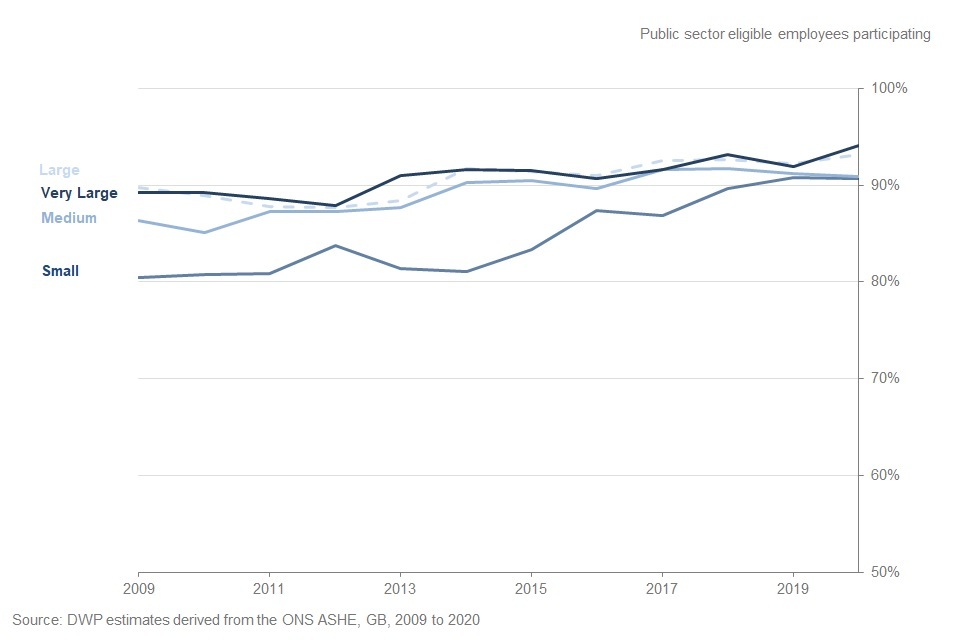
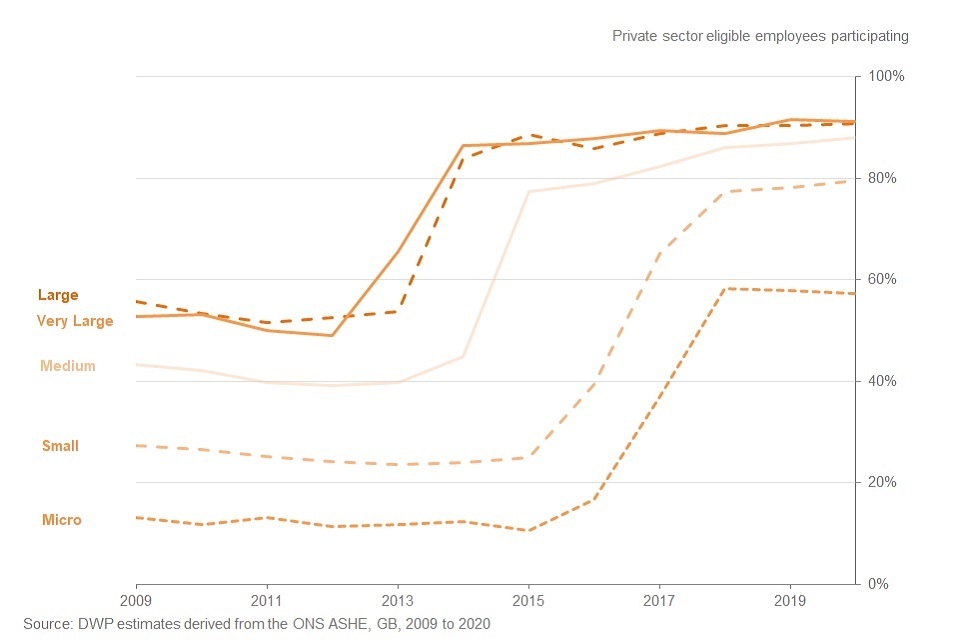
All employer sizes have seen large increases in eligible employee participation rates since the start of the relevant automatic enrolment staging date. Since the end of the staging period for each employer size band (with the exception of new-born employers coming into existence after April 2012), participation rates broadly stabilised.
The highest levels of both private and public sector participation in 2020 were seen in the larger employer bands. In the private sector, 91% of eligible employees were participating in the large (250 to 4,999) and very large employer bands (5000+ employees). In the public sector, participation rates of eligible employees in large and very large employer bands were 93 and 94% respectively.
Participation rates among micro (1 to 4 employees) and small (5 to 49 employees) employers have increased since 2012 to their current position of 57% and 80%. However, there is a persistent gap in participation rates of these groups and other sized employers.
In the public sector participation rates have remained stable for most employer sizes. Since 2014, participation rates for small employers (5 to 49 employees) have increased, largely closing the gap in participation by employer size. Participation rates for micro employers (1 to 4 employees) in the public sector are not shown due to small sample sizes. Greater gaps in participation among employer sizes persist in the private sector.
Staged implementation of automatic enrolment: The automatic enrolment duties were staged in between October 2012 and February 2018 by employer size, starting in October 2012 with the largest employers based on PAYE scheme size, to the smallest in 2017. New PAYE schemes between April 2012 and September 2017 were staged last, in 2017 and 2018. New PAYE schemes from October 2017 have immediate automatic enrolment duties.
1.2 Earnings, by sector
Higher earners continue to have higher participation rates for both sectors but the gap has narrowed.
Participation by earnings to 2020

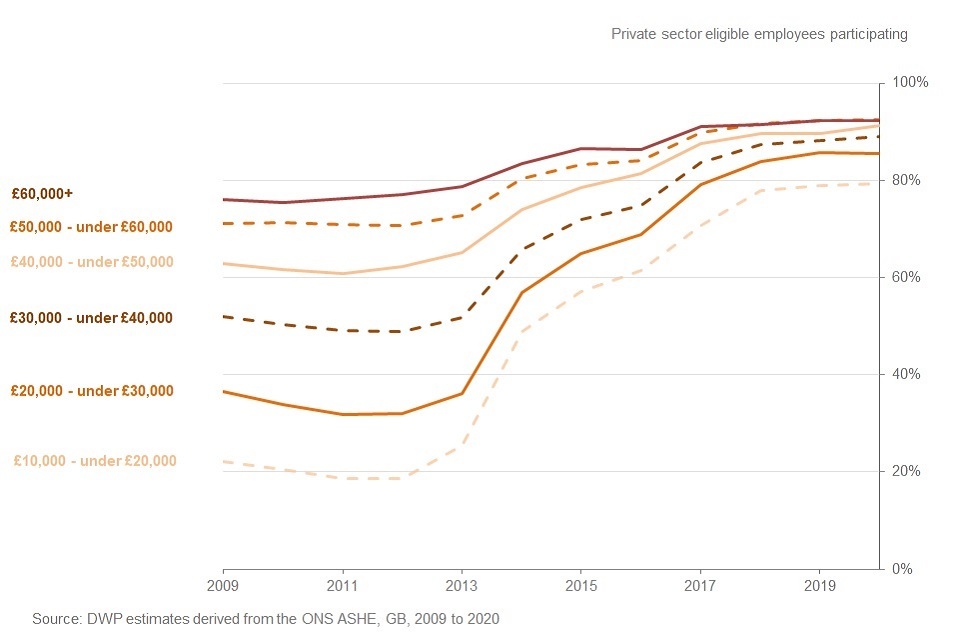
Across the whole economy those earning between £50,000 and £60,000 show the highest participation levels. In 2020, 93% of eligible employees within this earnings band were participating in a workplace pension.
In the public sector participation trends in higher earnings bands have been broadly stable since 2012 but larger increases have been observed in the lower earnings bands. The greatest increase was seen in the £10,000 to £20,000 earning band which rose by 14 percentage points between 2012 and 2020.
In the private sector the gap between the highest and lowest earners has narrowed since the introduction of automatic enrolment. The difference in participation rates between the highest and lowest earning groups was 58 percentage points in 2012, but has fallen to 13 percentage points in 2020.
Note that all earnings bands are defined in terms of individuals’ gross annual earnings in 2020 terms.
1.3 Age, by sector
The gap in participation rates between age groups for both sectors has narrowed since 2012.
Participation by age to 2020
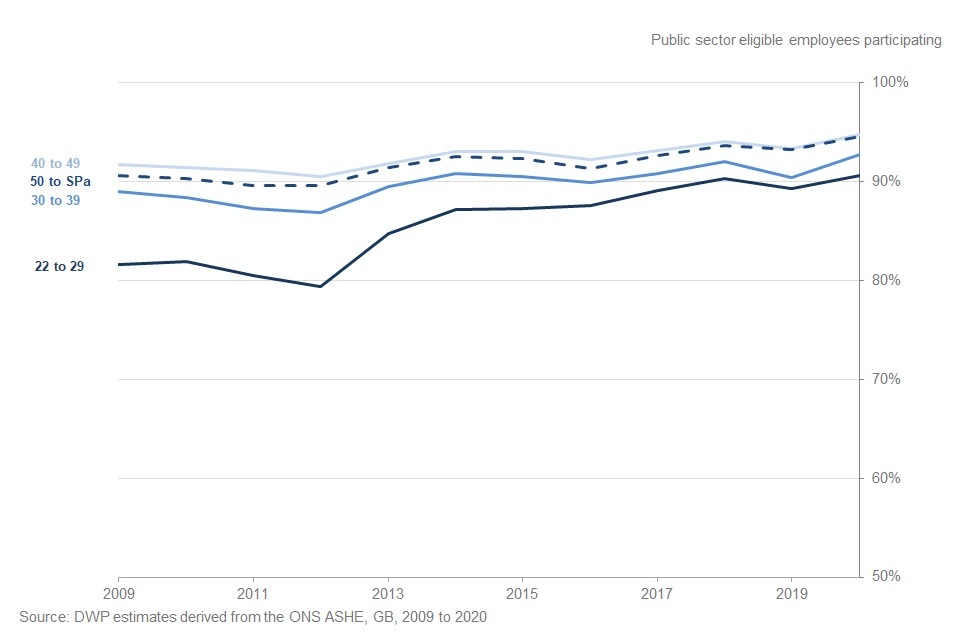

Across the whole economy participation rates for eligible employees in 2020 are highest for the 40 to 49 age group (89%) and lowest for the 22 to 29 age group (85%).
Participation rates in the public sector remain high and broadly stable since 2014. Despite narrowing after 2012, there is a small but persistent gap between the youngest and oldest age groups of 4 percentage points.
Since 2012, pension participation in the private sector has increased for all age groups. The largest increase was seen in the 22 to 29 age group, increasing from 24% in 2012 to 84% in 2020 (a 60 percentage point rise), and the pension participation gap between age groups has reduced since 2012 from 26 percentage points to only two percentage points in 2020.
1.4 Gender and working pattern, by sector
The male and female participation rates in the private sector have equalised for full-time employees but gaps remain between full-time and part-time employees and male and female part-time employees.
Participation by gender and working pattern to 2020
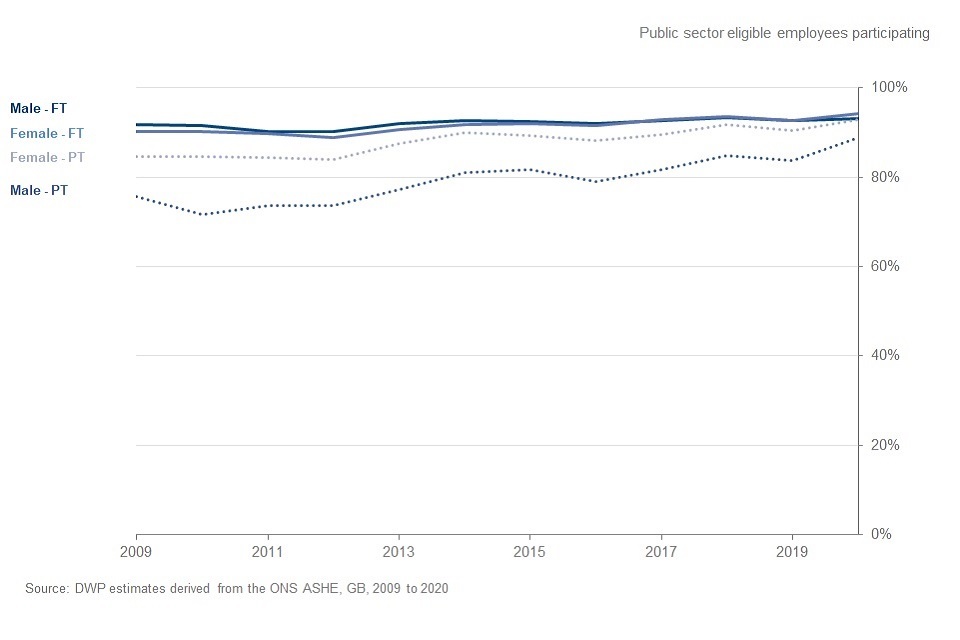

Across the whole economy there is only a small gap in participation rates by gender among full-time eligible employees in 2020 (88% for male employees and 90% for female employees). Among part-time eligible employees the gap is bigger: 86% of female part-time employees are participating compared to only 73% of male part-time employees.
In the public sector overall participation rates for both male and female eligible employees have remained stable, and were 93 and 94% respectively in 2020. Among full-time employees in the public sector, there was only a 1 percentage point difference between male and female employees (93 vs 94% ), while among part-time employees, the participation rate has remained persistently higher for female than male employees (93 and 89% respectively in 2020).
In the private sector overall participation rates for both male and female eligible employees were 86% in 2020, compared to 2012 when the participation rate for male employees was three percentage points higher (43% compared to 40% for female employees). The same trend of a narrowing gender gap since 2012 is seen among full-time employees in the private sector, and in 2020 the participation rate for female full-time employees (88%) was slightly higher than for male full-time employees (87%). Among part-time employees the participation rate has remained persistently higher for female than male employees (82% and 70% respectively in 2020), although the rates for both genders have increased greatly since 2012.
Every year around 15% of eligible employees in the Annual Survey of Hours and Earnings (ASHE) are classed as part time (i.e., working 30 hours or less per week or, for those in teaching professions, less than 25 hours per week). It should also be noted that part time workers may be more likely to be earning less than the trigger and therefore not included in the eligible population.
1.5 Industry, by sector
All industries have high participation rates in the private sector of 79% or above.
Private sector participation by industry to 2020
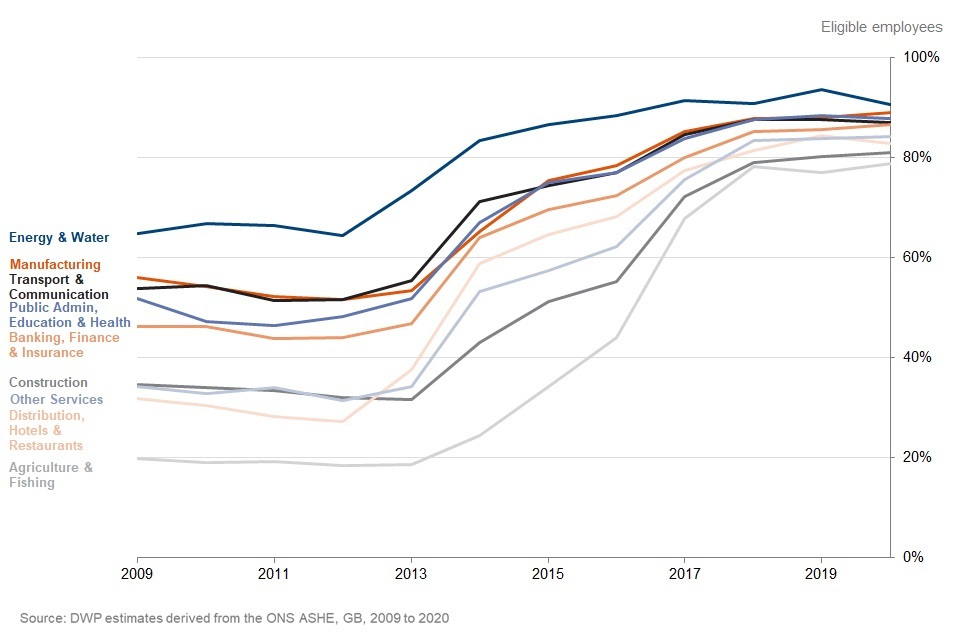
Across the whole economy in 2020, workplace pension participation was highest in the Public Admin, Education & Health industry with 92% of eligible employees participating and lowest in the Agriculture & Fishing industry with 79% participating.
In the private sector all industries have seen increases in participation since 2012, and the gap between different industries has narrowed. The industry seeing the largest increase in participation since 2012 is the Agriculture & Fishing industry, which saw an increase of 60 percentage points.
Participation in the public sector has remained high in all industries over the time series. Small sample sizes in the data mean that comparisons across industries in the public sector are less meaningful than in the private sector.
1.6 Occupation, by sector
All occupations have high participation rates in the private sector of 83% or above.
Private sector participation by occupation to 2020
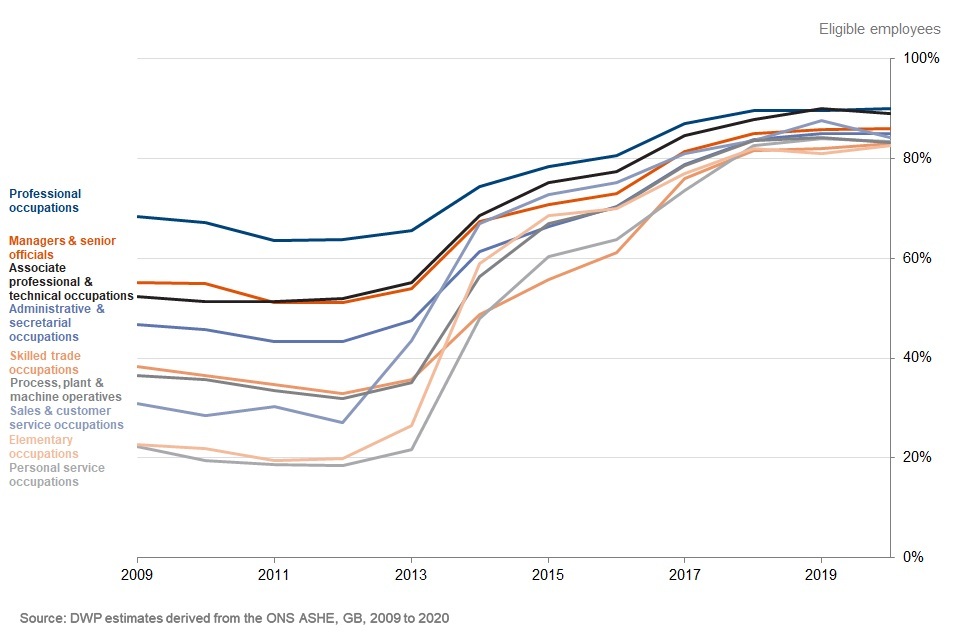
Across the whole economy workplace pension participation is highest in the Professional occupations with 92% of eligible employees in these occupations participating in 2020, compared to the lowest in Elementary occupations where 83% were participating in 2020.
In the public sector participation by occupation remains relatively stable with all occupations continuing to show higher participation levels than those seen in the private sector. Personal Service occupations (such as carers, travel agents and nurses) have shown the largest increases since 2012 of 14 percentage points, from 79% to 93% in 2020.
Since 2012, all occupations in the private sector have seen a large increase and the gap in participation between different occupations has narrowed. The largest increase could be seen in Personal Service occupations where the participation rate increased by 65 percentage points from 19% in 2012 to 83% in 2019.
1.7 Region, by sector
Gaps in participation rates between public and private sector have narrowed for most regions.
Participation by region and sector to 2020

In general there is little regional variation in workplace pension participation within sectors, with the exception of London and the East where public sector participation in 2020 is noticeably lower than elsewhere.
Within the public sector in 2020, the region with the highest levels of eligible employees participating in a workplace pension was Wales, with 96%. The lowest participation rate of 91% is observed in London.
In the private sector in 2020, the highest participation was in Scotland at 89% of eligible employees. The lowest, at 85%, was London.
1.8 Economic status, UK
Since 2012 to 2013, non-eligible employee participation has also increased to 34% but has declined for the self-employed to 16%.
Participation by economic status to 2019 to 2020
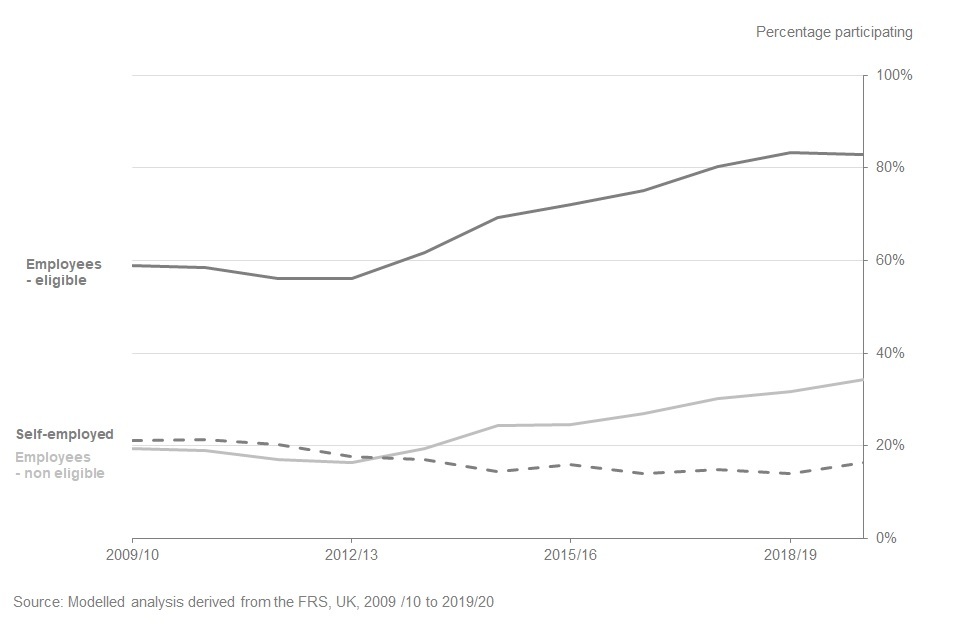
This analysis uses the DWP Family Resources Survey (FRS) to provide breakdowns by characteristics not available from ASHE but it is not possible to provide breakdowns by sector. More detail on this analysis can be found in the accompanying Background information and methodology note. Differences between the FRS and ASHE surveys mean the overall level of participation measures is not exactly the same. Nevertheless, both FRS and ASHE have seen similar long-term trends in participation. Automatic enrolment scheme participation has increased from 49% of employees in financial year 2012 to 2013 to 75% of employees in financial year ending 2019 to 2020.
For non-eligible employees the long-term trend has been a gradual increase from 16% in 2012 to 2013 to 34% in 2019 to 2020. Unlike employees, both eligible and non-eligible, the self-employed group has seen an overall long-term decline in participation from 21% in 2009 to 2010 to 16% in 2019 to 2020. Participation rates of non-eligible employees and self-employed both increased in 2019 to 2020 by 2.6 and 2.4 percentage points respectively.
Since 2012 to 2013, participation rates among eligible employees have shown a marked increase from 56% to 83% in 2018 to 2019. This trend is similar to that seen in the ASHE data, though participation rates have increased more over this period in ASHE (from 55% in 2012 to 88% in 2020) than in FRS.
1.9 Non-eligible participation, by sector
While trends in participation among non-eligible employees have followed a similar trend to eligible employees, participation rates remain lower.
Non-eligible participation to 2020
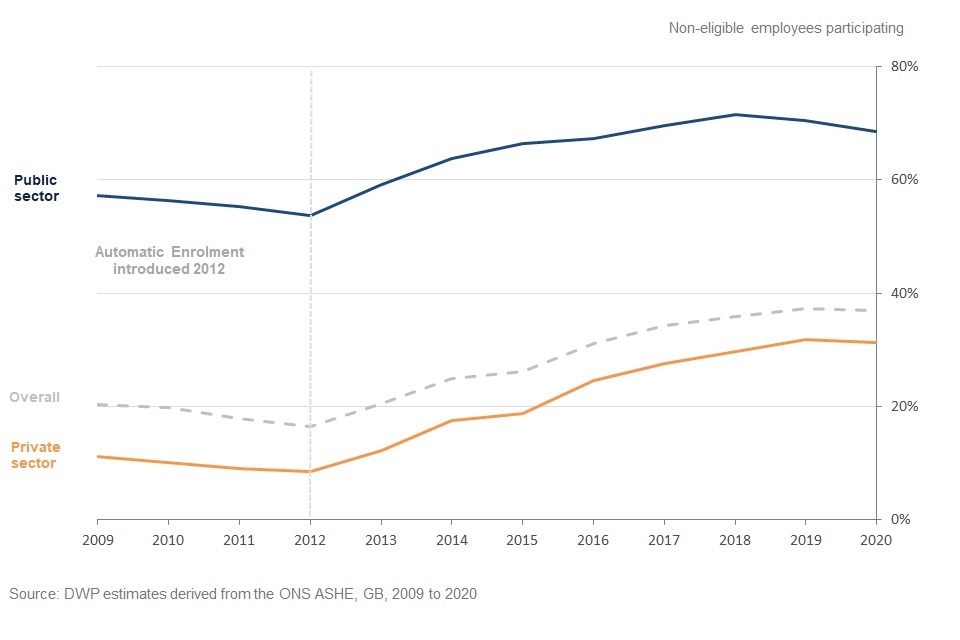
ASHE can be used to provide breakdowns on non-eligible employees by sector. Trends in non-eligible participation have been broadly similar in ASHE and FRS, except for the latest 1 to 2 years. This is likely to be due to differences between these data sources e.g. time periods. More details about ASHE and FRS are included in the background information and methodology note accompanying this release.
Non-eligible jobholders are individuals who earn below the Trigger but above the LEL, earn above the Trigger but are under 22 or above SPA or both earn below the Trigger and are under 22 or above SPA. Non-eligible jobholders are not automatically enrolled but can choose to opt-in to a workplace pension and receive a mandatory employer contribution.
Results from the Employers’ Pension Provision Survey 2019 included in the Automatic Enrolment Evaluation Report 2019 found 5% of employers with a scheme used for automatic enrolment had enrolled some non-eligible employees in 2018/19. This includes those choosing to opt-in or those enrolled as part of a company policy.
Across the whole economy, there was a general downward trend in workplace pension participation among non-eligible employees, from 20.4% (1.1 million non-eligible employees) to a low of 16.4% (0.8 million non-eligible employees) between 2009 to 2012. This is a similar trend to what has been observed among eligible employees. Since 2012, there has been a large increase of 20.5 percentage points (1.2 million) to 37% of non-eligible employees participating in a workplace pension (2.0 million) in 2020. However, participation rates among non-eligible employees fell in 2020 compared to 2019, driven by annual falls in both the public and private sector.
Public sector pension participation remains relatively high at 68.6% in 2020 (0.6 million non-eligible public sector employees), an increase of 14.9 percentage points since 2012.
The largest increases in workplace pension saving among non-eligible employees have been seen within the private sector. Since 2012, private sector participation has risen by 22.6 percentage points to 31.2% of private sector non-eligible employees participating in 2020 (1.5 million non-eligible employees). The gap between public and private sector non-eligible participation has remained large, only narrowing slightly between 2012 and 2020 (37.3 percentage points to 33 percentage points).
The vast majority of non-eligible employees participating in a workplace pension in 2020 were non-eligible due to failing to meet the automatic enrolment earnings criteria (71.8%). This reflects the overall breakdowns in reasons for ineligibility status of non-eligible employees, regardless of whether they participate in a pension or not. 57% of non-eligible employees were non-eligible because they did not earn at or above the £10,000 per annum threshold of the Earnings Trigger in 2020.
It should be noted that figures for non-eligible participation in this section will differ from the previous Economic Status breakdown due to different data sources.
1.10 Disability, UK
Since 2014 to 2015, there has been a small but persistent gap between disabled and non-disabled eligible employees with disabled eligible employees having higher participation rates than non-disabled.
Participation by disability status to financial year 2019 to 2020
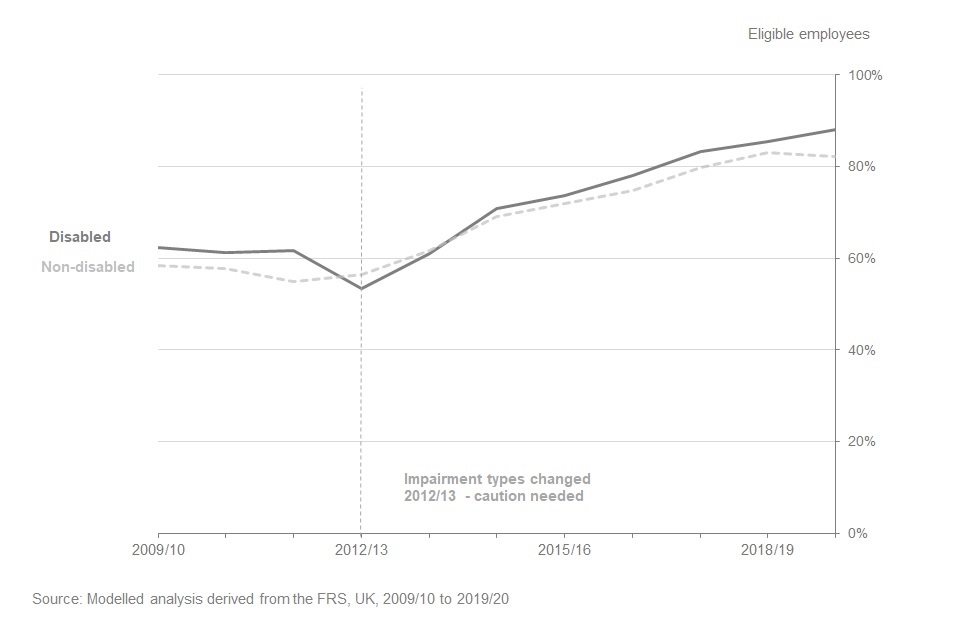
The FRS data can be used to show trends in pension participation for disabled and non-disabled eligible employees.
In 2019 to 2020 there was gap in participation between these groups which widened to 6 percentage points with 88% of disabled eligible employees participating compared to 82% of non-disabled eligible employees, compared to a participation gap of 2 percentage points in 2018 to 2019.
Both the disabled and non-disabled groups saw large increases between 2012 and 2020, rising 35 and 26 percentage points respectively.
The impairment types used to define disability status were changed in the 2012 to 2013 survey to reflect new harmonised standards and therefore caution is needed where making comparisons over time.
It should be noted that disabled employees are generally less likely to be in the eligible group according to FRS data.
1.11 Ethnicity, UK
Eligible employee participation continues to increase across all ethnic groups but the gap between White and Pakistani and Bangladeshi groups persist, currently 20 percentage points.
Participation by ethnicity to financial year 2019/20
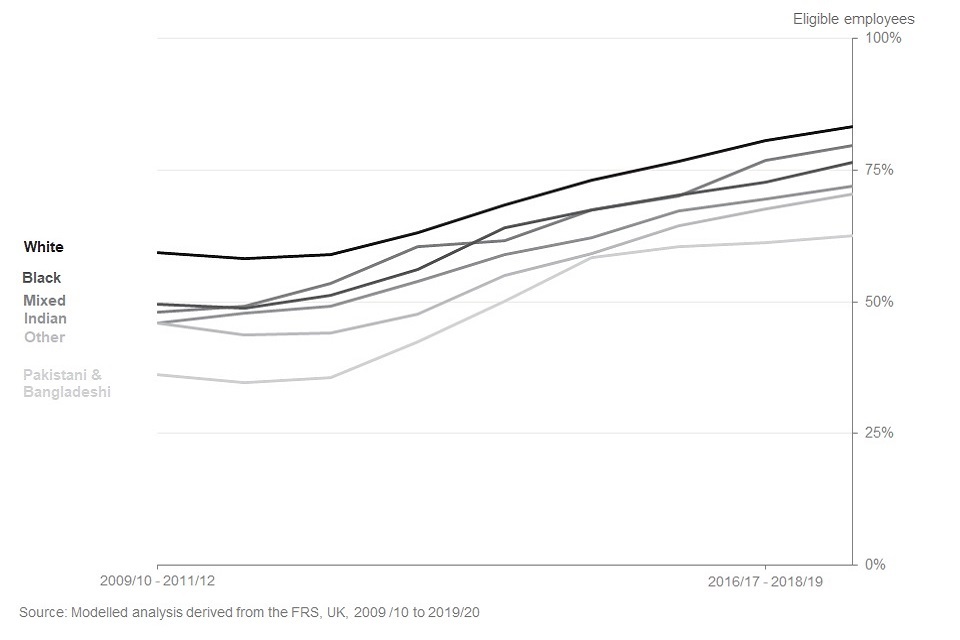
Note: Other ethnic group includes Chinese.
The FRS data can also be used to show trends in pension participation by ethnic group but three year rolling averages must be used to account for volatility in single year results which are caused by small sample sizes and clustering effects.
The White ethnic group has had the highest participation rate over the entire time series, and had an average participation rate of 83% over the period 2017 to 2020. This compares to the lowest, Pakistani & Bangladeshi group at 63%.
Between the 2011 to 2014 period and 2017 to 2020 there were large increases among all ethnic groups. The Pakistani & Bangladeshi ethnic group shows the largest increase from 36% to 63% (a 27 percentage point increase).
In comparison the lowest increase in the same period, 2011 to 2014 to 2017 to 2020, occurred in the Indian ethnic group. This group saw a 23 percentage point increase from 49% to 72%.
2. Persistency of saving
Overall nearly three out of four eligible savers are saving persistently.
Persistency of saving to 2017 to 2020
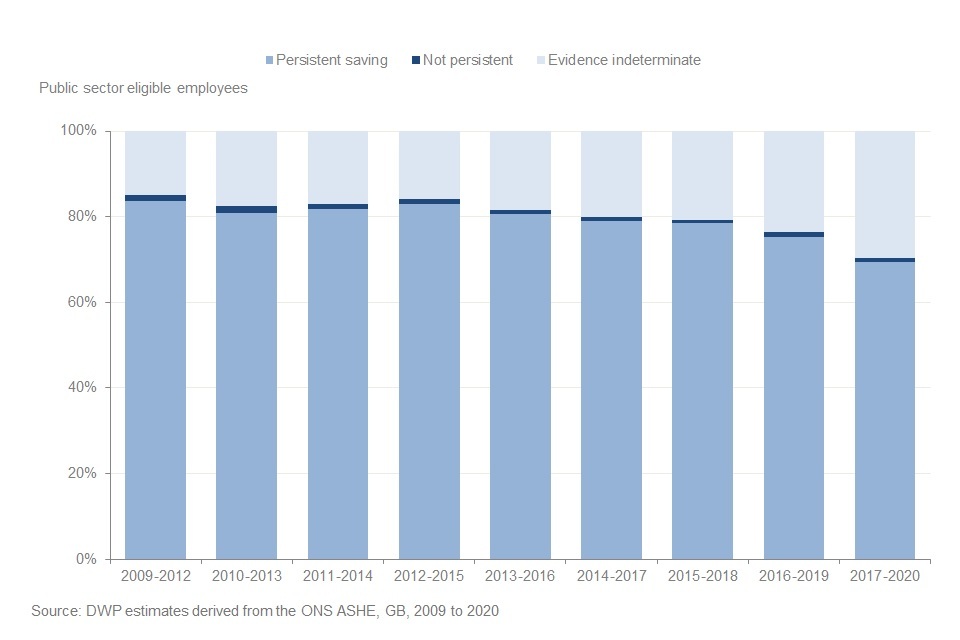
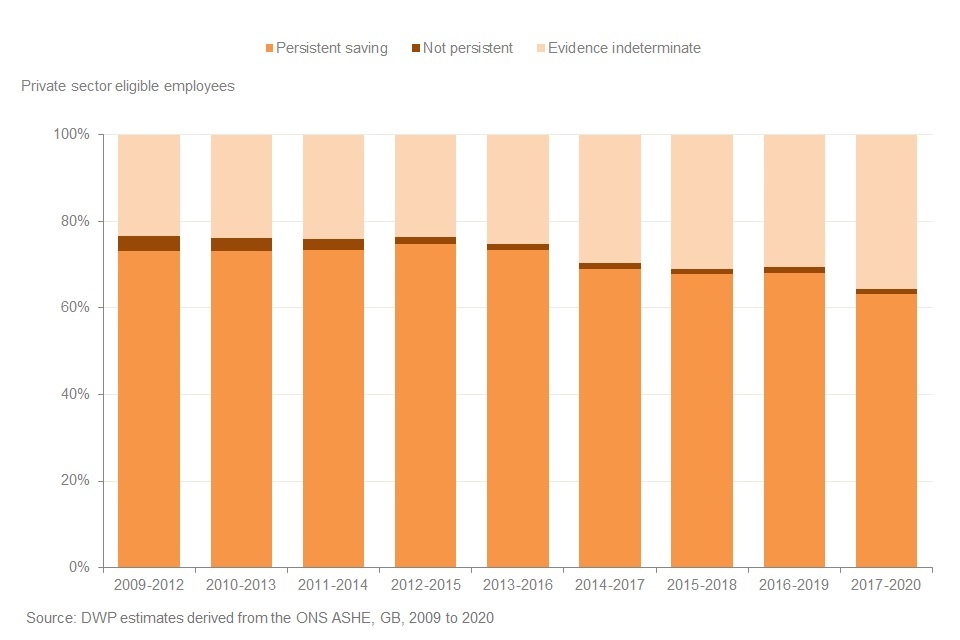
For the ongoing evaluation of automatic enrolment, the ASHE data is used to derive a persistency of saving measure to monitor the number of eligible employees regularly saving. For the cohort of eligible savers in a given year, those who are also saving in at least two of the following three years are defined as persistent savers.
An employee may no longer appear in the ASHE data due to leaving the labour market or moving to an employer who does not return the ASHE questionnaire. Those in a cohort of eligible savers in a given year treated as having indeterminate evidence of persistency fall into 2 categories: those not present in the data in at least two of the following three years, and (a smaller number) those who are saving in exactly one of the following three years.
Those in the cohort of eligible savers in a given year who are not saving in any of the following 3 years, and are not in the evidence indeterminate group above, are defined as not persistent savers.
Overall 65% of eligible savers in 2017 to 2020 were saving in at least two of the following three years. One percent of eligible savers were not saving persistently and for the remaining 34% there is indeterminate evidence.
The persistency rate has declined over time from 78% in 2009 to 2012. However, the proportion of eligible savers not saving persistently has remained at 1% over this period, and the decline in the proportion persistently saving is a result of an increase in the ‘evidence indeterminate’ group. The reasons for this are not clear, although there has been a small decrease in the ASHE response rate since 2014.
In 2017 to 2020, the proportion of eligible savers in the public sector saving persistently is 69%, while the proportion in the private sector is 63%. The proportion identified as not saving persistently is 1% in both sectors.
The proportion of eligible savers saving persistently in both the public and private sector has declined over time. The evidence indeterminate proportion has increased since 2012 in both sectors.
3. Trends in Contributions
Total annual savings for eligible savers increased to £105.9 billion in 2020.
Amount saved by eligible savers in 2020
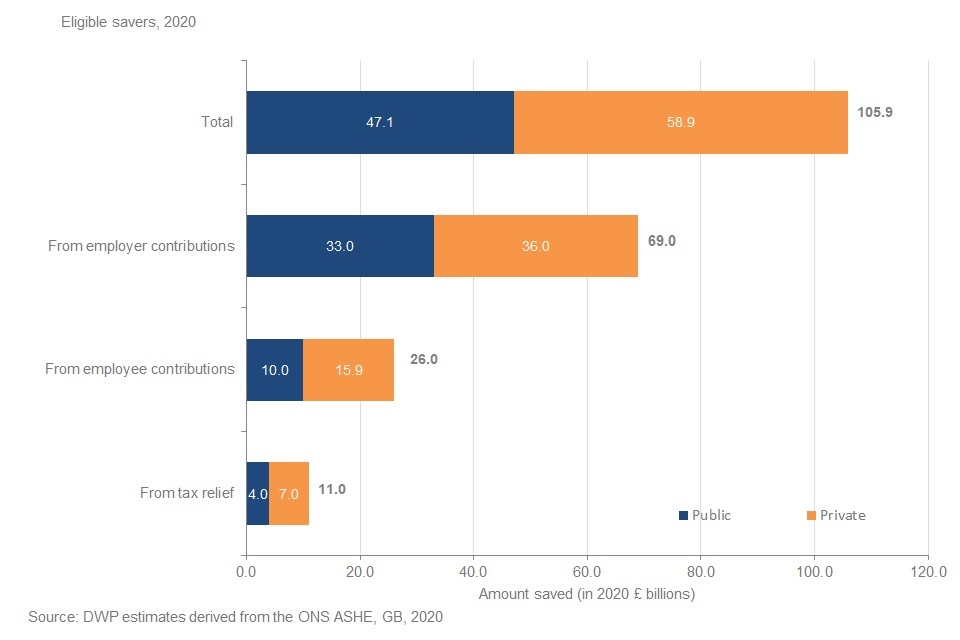
Minimum contribution rates under automatic enrolment started at 2% of qualifying earnings with at least 1% from employers. In April 2018, this increased to 5% with at least 2% from employers. In April 2019, minimum contribution rates increased to their current level of 8% overall with at least 3% from the employer.
The annual total amount saved for eligible savers across both sectors stands at £105.9 billion in 2020, which is an increase of £5.5 billion from 2019. Amounts saved in the public sector increased by £5.7 billion and decreased by £0.2 billion in the private sector.
Overall in 2020, contributions by employees accounted for 25% of saving, with employer contributions accounting for 65%, and income tax relief on the employee contribution the remaining 10%.
Amount saved per eligible employee increased in both sectors since 2012.
Amount saved per eligible saver and employee by sector to 2020
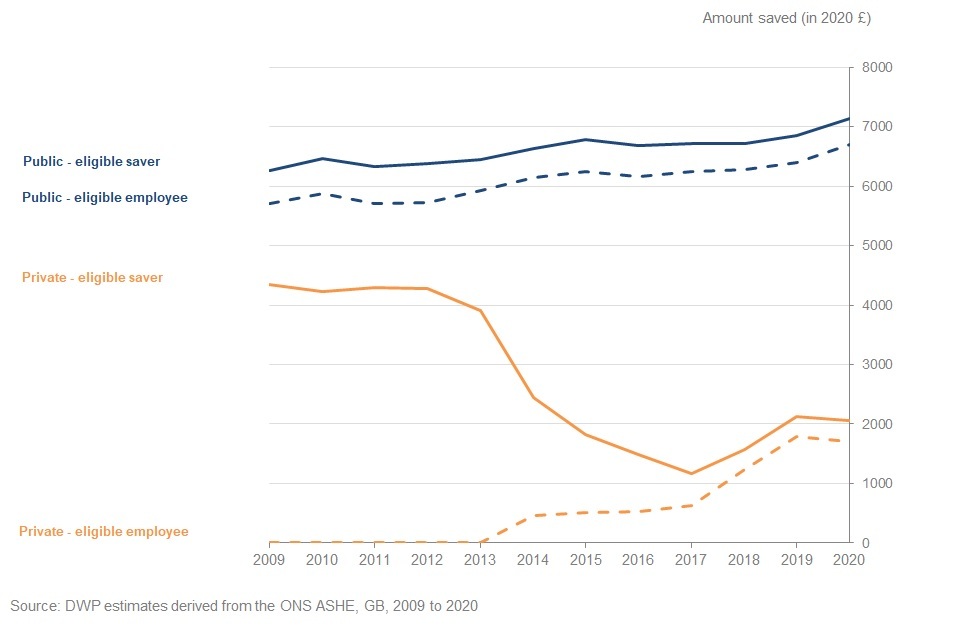
Note: Average amounts are calculated using medians. This means figures and trends may differ from previous publications which used mean averages.
Within the public sector there has been a gradual increasing trend for both the amount saved by eligible savers and employees. This reflects continued high participation rates in the public sector. In 2020 the average annual amount saved per eligible saver increased by £292 and the average annual amount saved per eligible employee increased by £298.
In the private sector the average annual amount saved per eligible saver showed several years of decline from 2012 to 2017. The falling trend was a result of the increased number of savers in the private sector many of whom will be making contributions at the automatic enrolment minimum level and therefore lowering the average. The average amount per eligible saver then saw large increases between 2017 and 2019, increasing £402 between 2017 and 2018 and £553 between 2018 and 2019. These increases are most likely attributable to the phased increases in minimum contribution rates. Following this, the average amount per eligible saver fell slightly by £66 in 2020. There has also been a gradual increasing trend in the amount saved per eligible employee, reaching £1713 in 2020.
Amount saved per male and female eligible savers in public and private sector have followed similar trends to overall sectoral amount saved trends. However, there are persistent gaps in average amount saved for male and female eligible savers in both sectors.
Amount saved per eligible saver by gender and sector to 2020
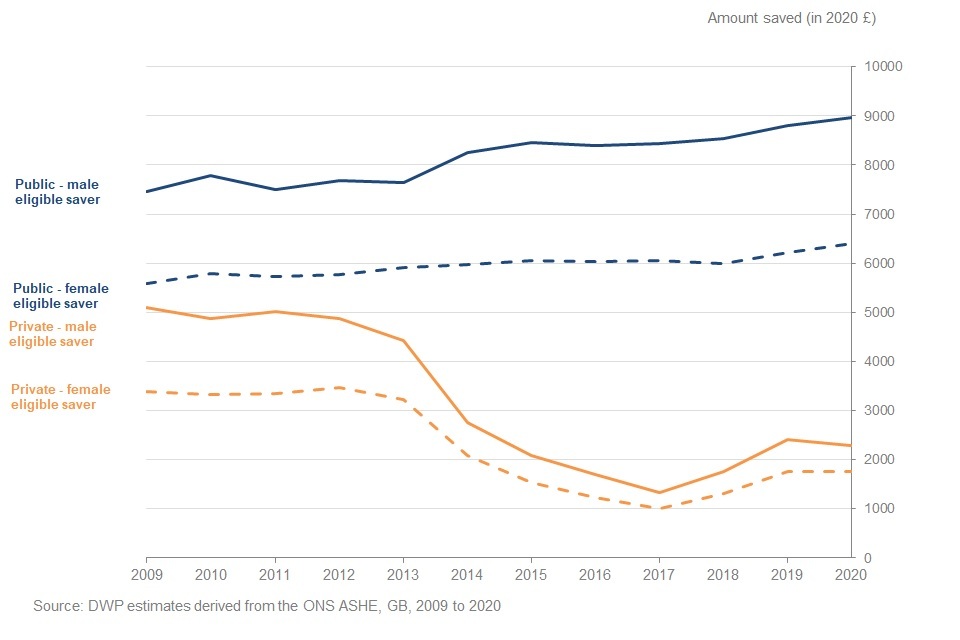
Within the public sector, the average amount saved per male and female eligible savers increased in 2020, by £161 and £189 respectively.
In the private sector, the average amount saved per male and female eligible savers both fell between 2012 and 2017, similar to the overall trend in private sector eligible savers. Following this, the average amount saved per male and female eligible savers increased between 2017 and 2019 during the phased increases in minimum contribution rates. The average amount saved per male and female eligible savers has fallen slightly in 2020, by £115 and £3 respectively.
Note that figures for annual amounts saved are derived by converting actual amounts saved during a single pay period in April of the corresponding year to an annual equivalent.
4. Trends over the COVID-19 period
Real Time Information (RTI) is the reporting system for earnings taxed via Pay As You Earn (PAYE). Under RTI, employers are required to report to HMRC information about payments made to their employees through the PAYE system, including details of tax and other deductions from pay. This is an update to the RTI information included in the Automatic Enrolment Evaluation Report 2019.
RTI does not collect information on employer pension contributions, so it cannot identify employments with employer-only pension contributions. Pension contributions made via salary sacrifice cannot be identified within RTI as pension contributions. Self-employed individuals are not required to submit RTI. Also note that the figures produced by RTI are based on employments eligible for automatic enrolment, both in the public and private sector. Due to the differences in population coverage and the methodology used, figures produced by RTI will not be directly comparable with other data sources – the focus of this section is to look for changes in RTI measures over time. RTI data in certain sections are presented using financial quarters. For example, Q1 refers to the period from April to June.
Stopping saving rates in RTI have decreased slightly compared to previous years.
Stopping saving rates to financial year 2020 to 2021

This section presents RTI stopping saving rates from April 2014 to March 2021. The RTI stopping saving rate is calculated as the proportion of all employments that are classed as stopping their workplace pension saving within each month on RTI. An employment is defined as stopping saving in the month of its final pension contribution. By looking longitudinally across payments for a given employment, we use the presence and absence of employee pension contributions to identify when pension saving starts and stops within an employment. RTI cannot identify cases where employees have been enrolled but they stopped saving before making their first contribution.
From April 2014 to March 2021, on average 2.7% of employments within RTI were identified as stopping saving each month due to either an active decision being made, the employment becoming non-eligible or the employment ending. Across this period, end of employments account for 64%, with active decisions accounting for 25%, and becoming non-eligible accounting for 11% of employments who are classified as having stopped saving.
In the financial year 2020 to 2021, the overall stopping saving level has decreased, mainly driven by a fall in those stopping saving due to ending their employment, which fell from 1.9% to 1.6%.
The active decision stopping saving rate (the proportion of workplace pension savers who make an active decision to stop saving within each period) has fallen slightly from 0.75% in the financial year 2019 to 2020 to 0.63% in the financial year 2020 to 2021, but has remained largely consistent with previous tax years.
The contributing eligible jobholder rate in RTI has remained stable in recent years.
Contributing eligible jobholders to financial year 2020 to 2021 Q4 (Jan to Mar)
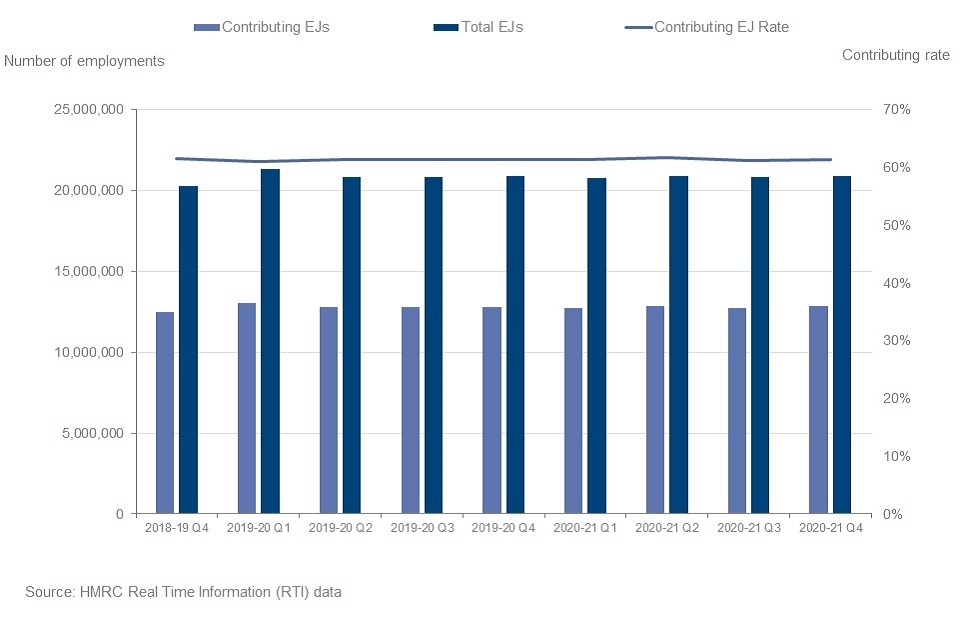
Note that for May tax months, there is a methodological caveat which leads to slightly inflated daily income, meaning more employments are classed as eligible.
This section presents the counts of eligible contributing jobholders compared with all eligible jobholders in RTI, known as the contributing eligible jobholder rate. This is produced from the number of people in employments who are listed as earning above the earnings trigger of £10,000 and are between the ages of 22 and the state pension age at the time.
Within RTI, there are 12.8 million eligible employments with an employee pension contribution as of the fourth quarter of the financial year 2020 to 2021. This accounts for 61.4% of all employments that are classified as eligible within RTI.
This contributing eligible jobholder (EJ) rate has remained stable since the final quarter of the financial year 2018 to 2019, remaining between 61% and 62%.
Employee pension contribution rates in RTI have remained stable throughout the financial year 2020 to 2021.
Employee pension contribution rates by AE threshold pay and full taxable pay to financial year 2020-21 Q4 (Jan to Mar)
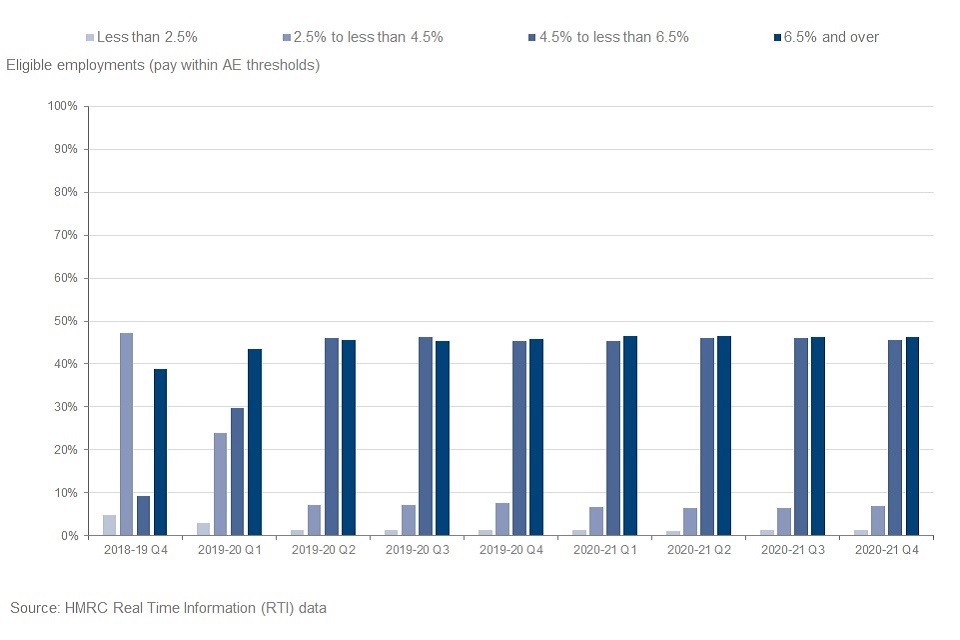

The RTI data can also be used to monitor employee pension contribution rates of each contributing employment. These contribution rates are calculated by using the pension contribution amount by taxable pay on the RTI reporting system. The pension contribution amounts used include tax relief.
These figures present the quarterly percentage of eligible employments by banded rate of employee contribution between February 2019 and March 2021. The figures are presented in terms of taxable pay falling within the lower and upper automatic enrolment thresholds, as well as percentage of full taxable pay.
Across both metrics, employee contribution rates in RTI have remained stable throughout the financial year 2020 to 2021, following a large increase in early 2019 due to the increase in minimum employee contributions.
Some PAYE schemes base their pension contribution rates using only the taxable pay that falls within the lower and upper automatic enrolment thresholds. When the contribution rate is calculated using this method, 92% of eligible employments with a recorded employee contribution are contributing 4.5% or more of this amount into their pension as of the fourth quarter of the financial year 2020 to 2021.
Not all PAYE schemes base their pension contribution rates using the automatic enrolment thresholds, so percentage of an employment’s full taxable pay can be used instead. As of the fourth quarter of the financial year 2020 to 2021, 50% of eligible employments with a recorded employee contribution are contributing 4.5% or more of their full taxable pay into their pension.
ONS Funded occupational pension schemes in the UK also includes information on employee contributions over the Covid-19 period. A fall in employee contributions was observed between Q1 (Jan to Mar) and Q2 (Apr to Jun) 2020, followed by a subsequent recovery in Q3 (Jul to Sep) 2020. Between Q3 (Jul to Sep) and Q4 (Oct to Dec) 2020, recovery continued with employee pension contributions increasing in all scheme types. These findings are broadly comparable with trends observed in HMRC RTI data, both showing that recent levels are similar to pre-COVID-19 levels.
About these statistics
The main data source for this publication is the Annual Survey of Hours and Earnings (ASHE) published by the Office for National Statistics (ONS) and is a key source of information on workplace pensions in GB as it collects information on all types of workplace pension schemes. The survey results are used widely to monitor the impacts of pension reforms.
Additional data sources used in this publication include DWP Family Resources Survey (FRS) and HMRC Real Time Information (RTI). FRS collects information on the income and circumstances of individuals living in a representative sample of private households in the United Kingdom. RTI is HMRC’s reporting system for income taxed via Pay-As-You-Earn (PAYE). The information is provided by employers and pension providers, with each submission within RTI relating to a payment to an employee or occupational pension recipient.
Full details of the data sources, their key assumptions, limitations and definitions are available in the Background information and methodology note.
Contact details
Produced by: workplacepensions.statistics@dwp.gov.uk
DWP Press Office: 0203 267 5144
Contact us for statistical enquiries and publication feedback only.
Consultation
We are committed to improving the official statistics we publish and therefore will be launching a user consultation to generate feedback on the long term future of this publication in Autumn to Winter 2021. Please check the Workplace pension participation and savings trends collection page for updates about this consultation.
Next edition: Date of release to be confirmed.
